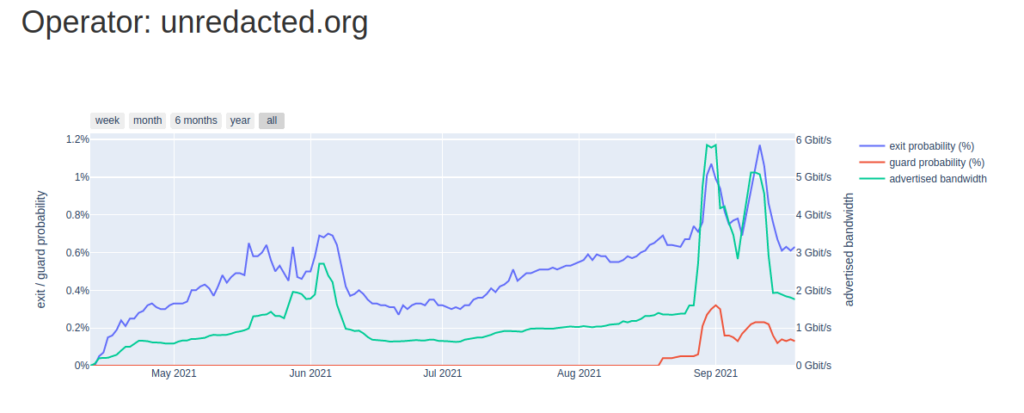
Internet usage has sky rocketed with COVID-19, and the internet is expanding, so are we. As you may have noticed, we have been putting a lot of work in to expand our Tor relay & bridge network. As of writing we have over 27 nodes which reside on a diverse set of networks. Today I would like to show you what our vision is for our segment of the Tor network and the network as a whole.

Tor is amazing, it provides a scalable and simple way to protect and anonymize your internet traffic. Whether it be purely layer 4 (e.g. TCP/UDP) or layer 7 (e.g. HTTP), the Tor network can route it. Tor does many things, but on a daily basis, it protects good people in censored and oppressed situations, providing a way for them to safely access the internet, and all for free with open source software. Because Tor is so great, it requires dedicated volunteers, relay and bridge operators to provide that bandwidth, CPU and RAM capacity. What’s so great is that we have so many individuals already donating their time and money to do this. However, I think we can do better. We should continue to expand the Tor network by providing more bandwidth and more reliable infrastructure for optimal routing with low latency and high throughput. Not only that, we should focus on diversifying the network and providing more relays and bridges running on top of diverse networks. That’s what we’d like to accomplish, and with everyone who loves what Tor does.
Sadly there are many relay operators that do not maintain their infrastructure well, falling behind on updates and doing little to no monitoring. By running stable and reliable Tor relays and bridges that vision of a better network ensues. We take into careful consideration potential ethical and security risks. The Tor Project team and community already protect against malicious operators and the network itself is diverse enough to handle that. However we should still do everything we can to protect the privacy of traffic that transits through our nodes. Our nodes run on top of various hosting providers, in various geographical locations. We favor providers that show a general respect for privacy and have a beefy network, no 100Mb/s rate limit with 1TB of bandwidth here. We also have our own ASN and IP space for exit relays: unredacted.org/about/network
To protect our nodes from compromise we do our best to harden against commonly exploited attack surfaces. Nothing fancy here, but we do our best at the moment. This requires a consistent state across all nodes. For this, we use Ansible (an automation tool) which allows you to automate the configuration of your computers. With this, we enforce a pretty strict SSH policy, iptables rules, packages that every node should have, Prometheus exporters, wireguard mesh (Tailscale), various others and the full configuration of our Tor daemons. For Tor automation, we use an Ansible playbook called ansible-relayor. All of this allows us to automate the configuration of our 27 Tor nodes, applying updates, and rotating keys just to name a few. Without this, manual configuration of 27 nodes would be an extremely painful and arduous process to say the least. In theory, we can now automate the configuration of every OS feature.
Protection is not the only thing, we need good monitoring too. To ensure consistent and reliable service, you just have to monitor your services. We make sure we have deep enough insight into our nodes, but without exposing any Tor user data. We do not log IPs, or analyze the netflows of our traffic. We collect basic metrics using Prometheus and node_exporter. Prometheus (+AlertManager) is configured to send notices through email for high CPU, RAM, disk, I/O load (and other things). We also have a 3rd party which notifies via email and SMS if something goes down. We hope to expand this in the future so that we can also collect route and packet loss statistics from outside sources that are looking into our network. Packet loss is a large cause of high latency, any way we can reduce that on our network would be crucial as the Tor network is typically already higher latency.
Now, how have we been doing so far? See for yourself! We made publicly accessible graphs and data points that show the utilization of our nodes. We’d like to be as transparent as possible, so these metrics do not contain any revealing info.
https://grafana.unredacted.net/d/ce-tor-relays/unredacted-tor-relay-metrics?orgId=1

As you could imagine, all of this requires funding to do. We ask that you help us build a better Tor network through your support and donations, or run your own node.
If you choose to donate, we accept many forms of payment, in addition to cryptocurrency. To donate, please visit our Donation page. Your donation will make a visible impact on the Tor network through our metrics. If you wish to be notified what your funds went to, we can give you the breakdown.
Thanks for your time,
Zach